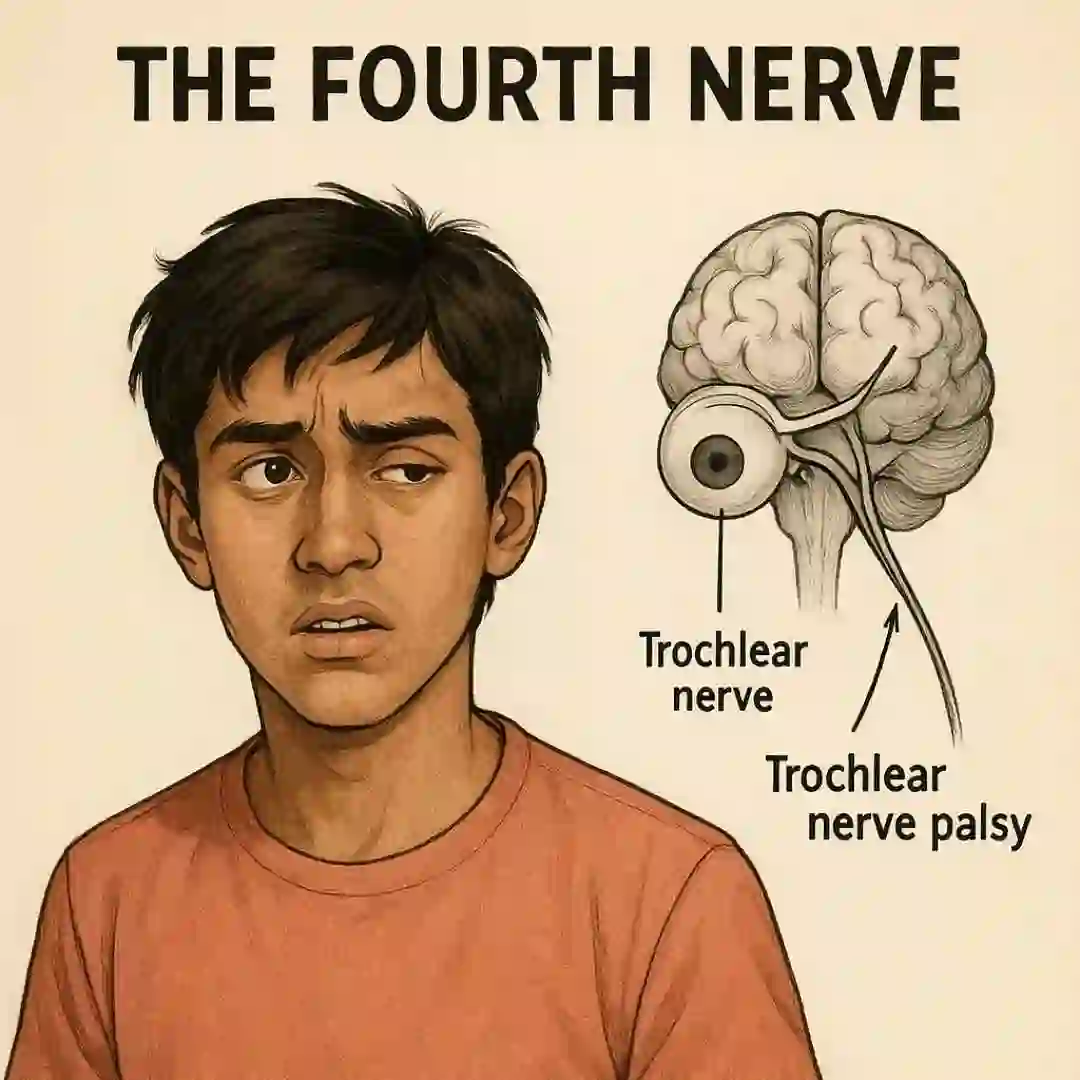“Doc, I think my eyes are playing tricks on me,” declared Vikram, a lanky seventeen-year-old who looked like he’d rather be skateboarding than sitting in my clinic. He sported a colourful cast on his left arm, a souvenir from a recent attempt to defy gravity, and his eyes darted around nervously, as if expecting the furniture to jump out and attack him. “Playing tricks how?” I asked. “Well,” he began, his voice cracking slightly, “everything seems tilted. Like, the world’s decided to lean over for a nap.”
Now, tilted worlds are usually not part of a teenager’s everyday experience, unless they’ve been experimenting with substances best left to horticultural enthusiasts. Vikram, however, assured me that his only indulgence was an overabundance of video games. A quick examination revealed the culprit: his left eye was doing a subtle ‘up and in’ impression, as if trying to get a better view of his brain. Clearly, the fourth cranial nerve, the delicate little trochlear nerve responsible for guiding the eye's downward and inward gaze, had decided to take a vacation.
“So, what’s the damage, doc?” Vikram asked, his voice a mix of bravado and genuine concern. “Is this going to be like a permanent tilt-a-whirl situation?”
“Not necessarily,” I reassured him, launching into an explanation of how the fourth cranial nerve, the slenderest of all the cranial nerves, could be affected by head trauma. I may have gotten a little carried away with the anatomical details, because Vikram’s eyes started to glaze over, as if he were contemplating the nutritional value of the ceiling tiles.
“So, basically,” I summarized, “your fourth nerve is a bit bruised, but it should recover with time.” I prescribed him some eye exercises and a healthy dose of patience, which, for a teenager, is like asking a hummingbird to stand still.
Over the next few weeks, Vikram became a regular fixture at my clinic. He’d come in complaining that his eye was still doing the ‘tilt-a-whirl’ thing, but his complaints were peppered with increasingly outlandish descriptions. One week, his vision was ‘like looking through a kaleidoscope that’s been attacked by a squirrel’. Another week, it was ‘like the world’s doing the macarena’. I began to suspect he was secretly enjoying his newfound ability to describe his visual experience in terms that would make a poet blush.
But beneath the humorous exaggerations, I could see that Vikram was frustrated. He was struggling to read, to play his beloved video games, even to walk down the street without feeling like the ground was sloping away beneath him. I reassured him that his recovery was progressing, albeit slowly, and that his brain was remarkably adept at adapting to such challenges.
And indeed, it was. Slowly but surely, the tilt in Vikram’s world began to subside. His eye exercises, though performed with the enthusiasm of a sloth on a treadmill, were helping to strengthen the weakened nerve. His brain, meanwhile, was busy rewiring itself, finding new ways to process the visual information it was receiving.
Three months after his initial visit, Vikram walked into my clinic with a swagger. His cast was gone, replaced by a faded scar that looked like a lightning bolt, and his eyes were bright and focused. “Doc,” he announced, “I think my world’s finally back to normal.”
I examined him carefully, and sure enough, his fourth nerve had made a full recovery. His eyes were aligned, his vision was clear, and his descriptions of his visual experience had returned to their usual teenage simplicity. “Well, Vikram,” I said, “it seems your fourth nerve has finally decided to come down from its vacation.”
Vikram grinned, a mischievous glint in his eye. “Yeah,” he said, “and I think it brought me back a souvenir.” He tilted his head slightly, and for a fleeting moment, I thought I saw a hint of the old tilt in his vision. But then he winked, and I realized he was just messing with me. After all, what’s life without a little bit of tilt?





12 thoughts on “The Fourth Nerve”
Happy to c how medicines exercises n a lil patience cld help the young lad!!
Such colourful and humorous visual description by the patient and Doctor….so happy that as diagnosed by our favorite doctor, there was no surgery involved! Bless you Doctor Mazda!
Good description of fourth nerve palsy.Keep it up
Glad you’ve written about this rare case. Continue the good work
Great info. Thanks doc. Increased my knowledge base.
After 40 + years of graduation even i had forgotten 4th nerve innervation. Glad you revised it for me.
Enjoyed reading the article and learning something from it. Also happy to read that the boy recovered fully.
Well said Doc…
Words are failing me, and yet I’ll sum it up in one word to describe you ‘Genius’ 🙌🏻
I may not be good to explain that is the brain job, but with once EYE I better not play games. Good luck to your Vikram.
Doctor, u have given us a wonderful information. Now if we something similar to Vikram we will be alert.Nice experience u had with hiim.These young generation teenagers help older ones to get spice into everyday bland clinic job.enjoyed the writing as usual.
Genius doctor 👍👌👌
Glad eye exercises can do the job at times and don’t need medical intervention. 👏